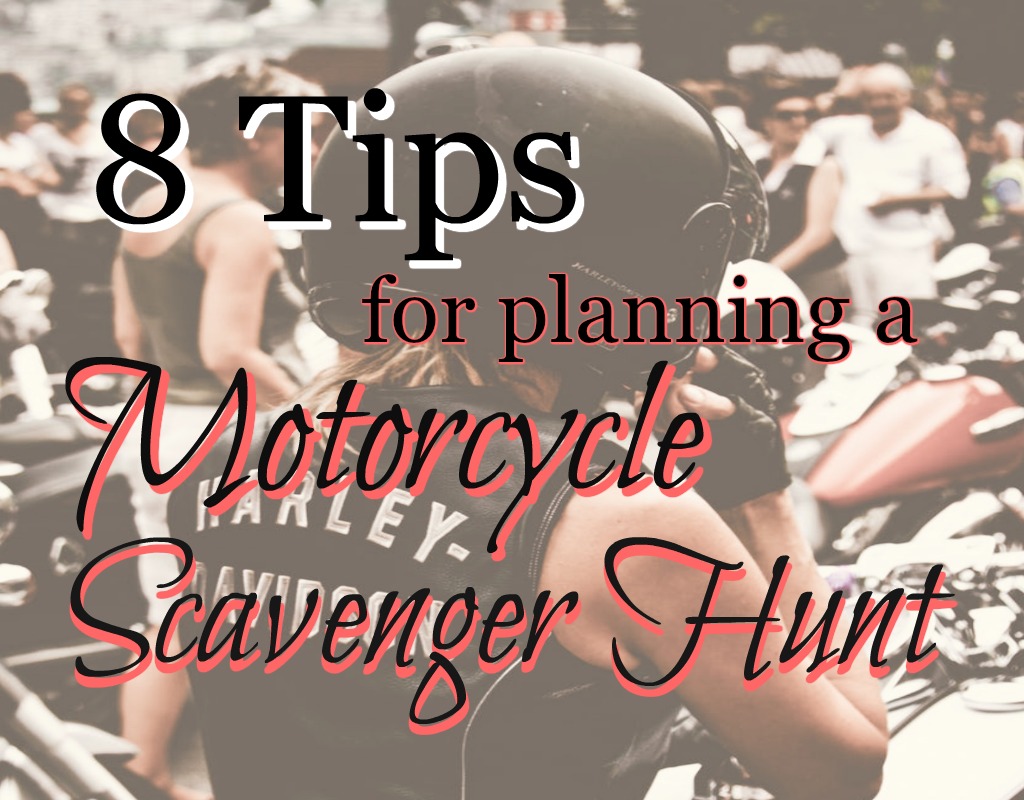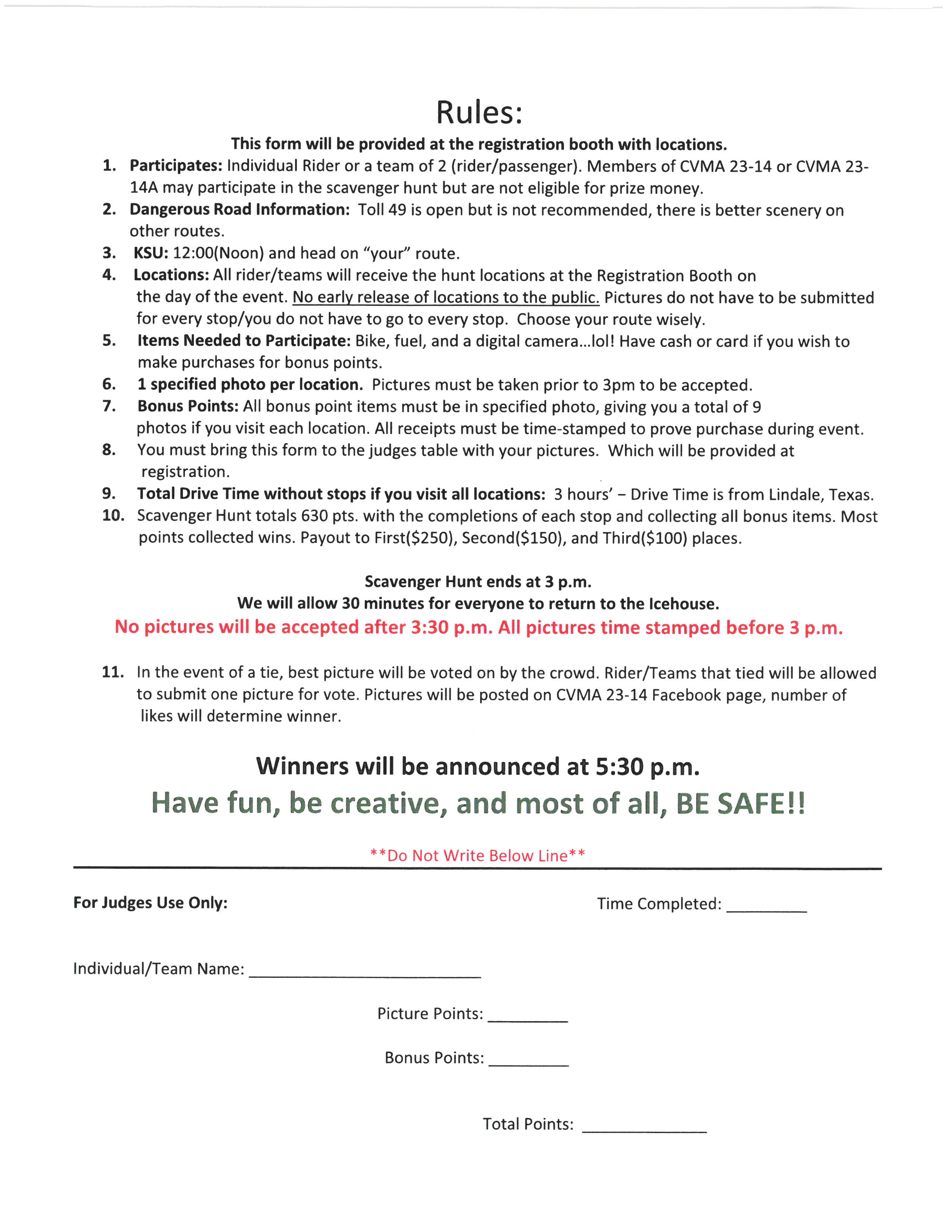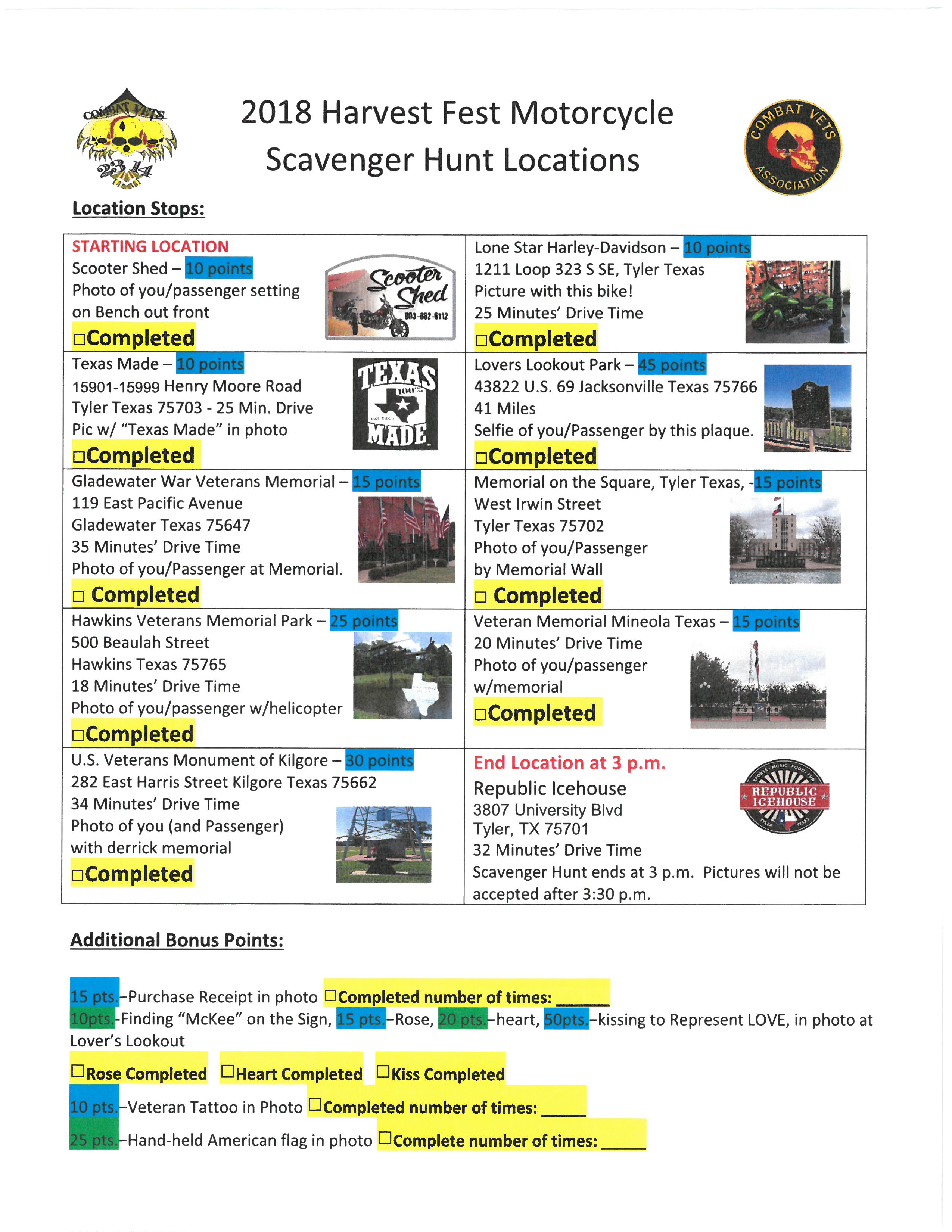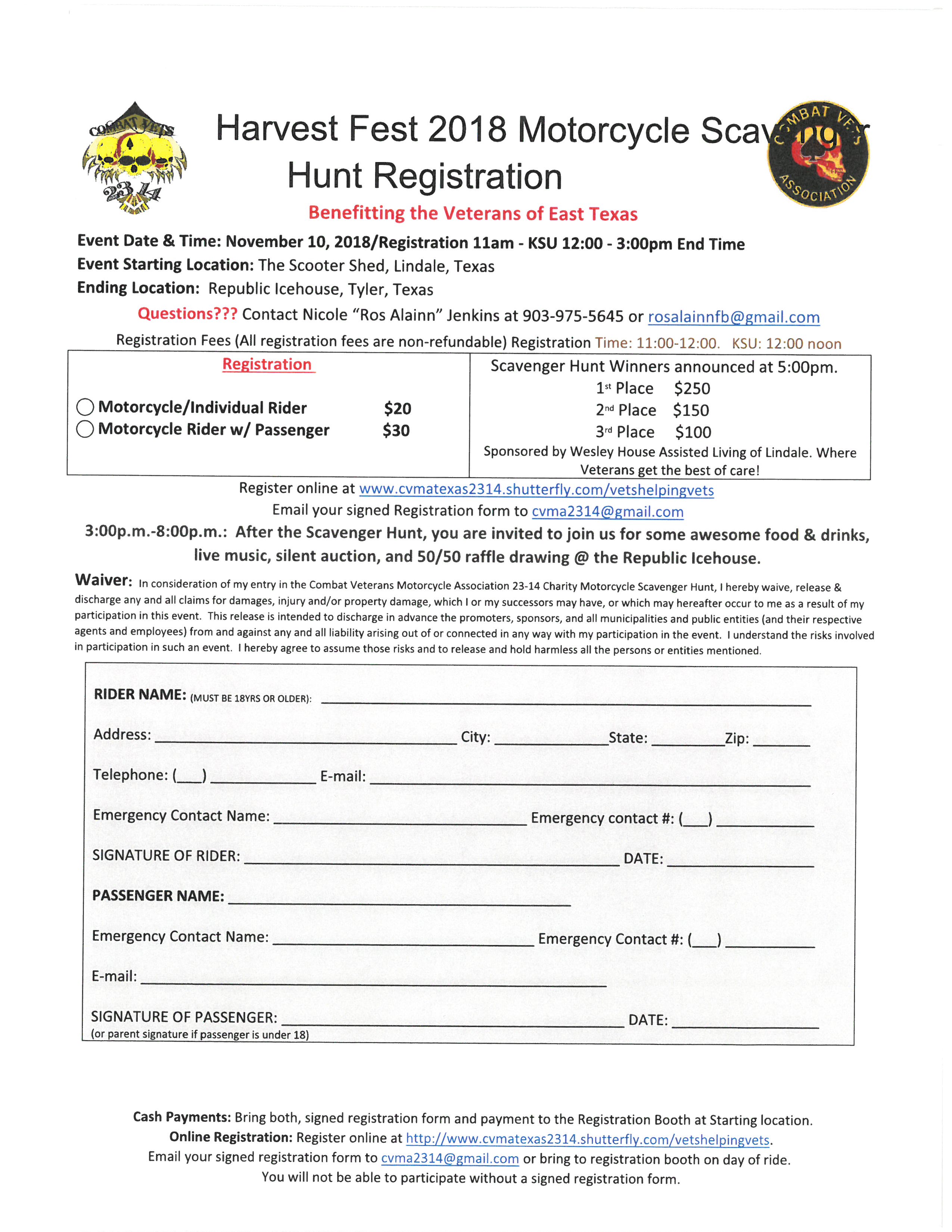
Motorcycle Scavenger Hunt: 8 Tips to Help Plan a Successful Hunt
Motorcycle Scavenger Hunts are so much fun! Many motorcycle associations/clubs host them just for fun or to raise funds for a cause. In other words, if you have never participated in one, I encourage you to sign up for the next one you see happening in your area. You will not be disappointed. Whichever you choose, fun or fundraising, below you will find 8 tips that will help you organize and plan. Creating the necessary forms to protect yourself or your association/club from liability, developing your rules and regulations, and creating a point system and payout that limits drama and confusion.
In this post, I will highlight each of these tips. I used this method of planning for the scavenger hunt held by CVMA 23-14 last year. You can read more about this event by clicking here.
I will take each of these tips and go into more detail in upcoming post. Taking each one and walking you through the process.
-
Determine Your Purpose
To start with, you need to do when planning a motorcycle scavenger hunt is determined your purpose. Is this hunt going to be held for fun or is it going to be used as a way to raise funds for a specific cause? It works well for both. I planned the hunt as a fundraiser for supporting the Veterans of East Texas.
Once you have decided whether you are planning for fun or a fundraiser you will need to decide when you want to hold your ride. What season of the year? Is it to be centered around a Holiday? Of course, most of us are looking at late spring, summer, or early fall. Once you have decided when you want to schedule your hunt and if a holiday will be involved, you will find the next tip much easier. One thing you must do in choosing a date is to check for any competing events being held in the area. This could have a massive impact if you are planning your hunt as a fundraiser. I have learned to take these 6 steps when choosing an event date.
2. Determine Your Theme
Research is a must for this step. Therefore, you will need to do research based on your purpose and chosen date. With 23-14’s hunt, I knew that it was going to be a fundraiser and that they always hosted their annual fundraiser in November. So, I had the purpose, raising funds to help support Veterans of East Texas, and I also knew the time of year. The common thread between the purpose and date were Veterans. That made choosing a theme extremely easy. The theme of their hunt would be Veteran Recognition.
The theme ideas are endless. If you have settled on your purpose and event date, be creative and have fun with this part. It will render you outstanding results.
3. Determine Your Locations
Now that you have chosen a theme you can now choose your locations based on that theme. 23-14 chose Veterans Memorials, Motorcycle shops, and a few locations based on the actual ride itself. What comes to mind when you say the name of your theme out loud to yourself? Now make a list. Think of locations related to the items you put on your list.
Length of Ride
At this stage of planning, I would also advise you to determine how long you want your hunt to last. Make a list of possible locations and map out the miles from the start location and how long it will take to ride there. With your hunt time in mind, add up the ride times to each location. If you are close or a little over your hunt time, that is fine. As an example, 23-14’s hunt was to last 3 hours, starting at Noon and ending at 3 p.m. The sum of all location ride times from the starting location was exactly three hours. This does not take into consideration times for stops the rider will have to make to snap their pictures. This makes it interesting. Everyone will have to map out their own ride to try and complete as much of the hunt as they can. No one will be able to ride straight through and complete the hunt within the allotted time.
If needed, now that you have narrowed down your list of locations, contact those who are responsible for the location and ask them if it would be ok to include them in your scavenger hunt. Once you have secured your locations do not release them to anyone until the day of the hunt.
Safety
Be aware of all traffic patterns and road conditions leading to your locations. Make sure everyone can stay safe. In fact, if a specific road is congested with traffic or pavement is deteriorating and unsafe to ride on, list those dangerous roads in your documentation. With safety being of utmost importance, I would personally ride on a bike to each location. This gives you a personal feel of what your riders will be experiencing and help you with the next tip, determining your photos.
4. Determine the photos you are going to require the riders to snap.
This is where it can get fun. For these photos, specific photo requirements were listed. For example, a rider/passenger taking a photo with the memorial name in the photo. You can choose specifics based on your theme and locations. After completing this hunt, one of the things I would have done differently is not making the photo so generic and easy to achieve. I would have been more creative with these photo requirements.
5. Choosing Bonus Points
Bonus points can be more subjective. Choose what you want to be your bonus points in each photo and then let the rider/passenger be open to their own interpretation of that bonus point. It can be so funny seeing your riders think out-of-the-box and make these happen. For instance, the location was lovers lookout. The bonus points, a rose(15pts), a heart(20pts), and a kiss(50pts). We had a rider that posed for the specifically required photo, and after explaining his situation, asked a man if his girlfriend could kiss him on the cheek while the boyfriend took the photo. Low-and-behold, the two did not hesitate and now all three of them have a story to share.
6. Rules and Regulations
Now that you have worked through steps 1-5, you will now need to create the rules and regulations for your hunt. I specifically created a form that consisted of Rules and Judging notes on one side and Hunt locations on the other.
Clear and Precise
Most importantly, you need to be really clear on your rules and regulations. You do not want any of your riders to misunderstand any of the requirements. Start with who you are going to allow to participate in your hunt. If it is just for fun, you can open it to your friends, your organization, or even the public, but if you are using it as a way to raise money, you want to make sure that you are as fair as you can be. This may include more than just everyone playing by the rules. You do not want the perception that the hunt was rigged or unfair, for this reason, 23-14’s hunt was open to the public and any member of the CVMA not in 23-14. 23-14 member chose to not participate in the effort to maintain the trust of those who paid their hard earned money to support them and help them raise money to further their mission of “Vets Helping Vets”.
You will also need to determine if you are going to let teams consisting of a certain number of bikes with riders/passengers (Team-4 bikes with rider/passenger) participate or if you are just doing individual participation (1 bike with rider/passenger). If you choose to use the team participation, I suggest that you have a Team Captain for each team, The Captain would be responsible for the pictures and making sure all team member follow all the rules.
You need to include the items needed to participate in your hunt. They will need a bike, fuel, cash or card if purchases are required for bonus points and a digital camera. Cell phones have made this very simple.
Photo Requirements
Include your photo requirements. This can be at your discretion, but say they need 1 specific photo per location and time-stamped so you know they were taken during the scheduled times of your hunt. Explain bonus point items are to appear in the specific photo and not be a 2nd photo taken at the location. This keeps it to one photo per location and makes judging and point counting easier. If the rider was required to make a purchase at a location and the receipt is the bonus point. They need to make sure that the receipt is time-stamped to guarantee that the purchase was made during the event. Explain what you are going to do in the event of a tie. You can have each rider/team can submit a picture to be voted on by the crowd. Facebook is a good platform for this. Post the pictures on yours or your organization’s Facebook page and have the crowd vote with likes. The picture with the most likes wins the tie.
You want to be clear of KSU and your hunt end time. Have someone be in charge of staging bikes at the starting location. Make sure you have the required number of judges at the end location to collect points and determine winners. This will depend on the number of participants you have. Of course, make sure your riders know exactly what to do at the end of the hunt.
7. Create the Necessary Forms
In addition to the tips mentioned above, you will also need a way to register participants, collect fees, and a liability waiver to provide protection to you and/or your association/club.
Remember, when registering your participants, to collect all the needed information you will need to process the registration. This should include personal information including rider/passenger names, address, telephone number, and email. You will also need to collect emergency contact information.
Your registration form should include your liability waiver, registration fee (team/individual rider/ rider with passenger), and contact information if someone has questions.
Furthermore, include instruction on where to mail the registration form, register online, or will it be accepted on the day of the hunt. Also, you will need to include instruction on how to pay the registration fees. Will you have an online registry and fee payment, accept credit cards or just accept cash/check payments? Will there be an early-bird registration with a cheaper registration fee?
Make sure you have a signature from each participant on their registration form verifying that they are agreeing to terms and conditions of the liability waiver and hunt requirements. This includes both riders and passengers.
8. The last tip is to enjoy yourself.
Most importantly, successful events take dedicated planning, organizing, and volunteers. With all the hard work that goes into planning a successful Motorcycle Scavenger Hunt remember to have fun. There will be times when things don’t go as planned, and that is ok. As long as everyone is safe, you can keep note of what didn’t work, what worked really well, and what you can improve. Above all, I hope using the seven tips listed above will help you maintain your sanity while planning an event that you are sure to be asked to host again.
If you need any help or just want to bounce ideas concerning a Motorcycle Scavenger Hunt or other motorcycle events, contact me. As a matter of fact, I would love to connect with you and celebrate your successes at planning motorcycle events. Don’t forget to follow Ros Alainn on Instagram and Facebook.








